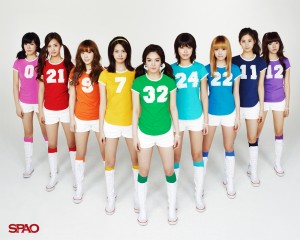In some ways, K-pop has a stronger hold on us than we would like to admit. Despite being unwilling to admit it, at times we end up making far more concessions in our lives just to fit it in. From saving up frantically to afford concert tickets and physical albums, to defending our interests in the face of friends who consider K-pop to be a “plastic surgery-addled waste of time”, the things we do for K-pop can at times be considered a personal sacrifice of sorts.
Happily though, there are other ways K-pop has integrated more neatly into our lives. Although they do reflect our obsession, at least it is not as obvious or as taxing as the afore-mentioned examples.
Below are a few examples of how K-pop has nicely integrated into some less noticed aspects in our lives.
The Calendar:
Throughout history, calendars have served as a way of marking out a year in progress, and we have functioned with various iterations of it, ranging from the Gregorian ones to Lunar ones. The proliferation of K-pop however, means that the tried and tested calendar has been rebuilt around K-pop, allowing the most ardent of fans to distribute support year round, as well as note the acts to watch at what point of the year.
 It seems that these days, the months in a year can practically be pegged down to when varied groups or artistes come back. In fact, there are some months where group comebacks come pretty heavy. A good example would be the September to November periods, where the heavyweight girl groups make comebacks almost all at the same time.
It seems that these days, the months in a year can practically be pegged down to when varied groups or artistes come back. In fact, there are some months where group comebacks come pretty heavy. A good example would be the September to November periods, where the heavyweight girl groups make comebacks almost all at the same time.
Then there is the lull period between January and March, which is the opportune time window for a new group to debut, or for a b-list group to snatch that all elusive chart show victory, away from the Big Companies’ Marketing Muscle. And Super Junior can always be counted to drop a release near the middle of the year, for optimum sales figures.
And of course, IU has over the past two years reliably put out an album near the end of the year, just in time to make it onto music critics “albums of the year” lists very nicely.
Sure, most of these patterns have emerged over the last two years, and that there are anomalies (SNSD-TTS this year springs to mind) at times, but for the most part, comebacks by artistes throughout the year have fallen into a very nice clockwork pattern, making for a very nice alternative calendar.
Below is a good example of the K-pop calendar©:
January to March: Where a big act times their debut for guaranteed wins, or a smaller act tries their luck. Also a safe time for rookie acts to appear.
April to May: Usually a further slow down in releases, making for a better time to try for wins, and gain attention.
June to August: The heavy hitters start appearing, mostly guy groups from one of the big 3, but usually co-ordinated such that they do not need to go head-to-head with Super Junior, who usually win it all.
September: A slower month where decent groups usually make a comeback for a win to cement their status as having arrived.

October-November: Girl group overload! Mostly when SNSD and every girl group worth their salt in K-pop land battle for sales,music show wins, and the all important positioning for year end awards.
Also probably the worst time for any new act to debut, partly because no one would really care, and if they are female, subject to comparison with the establishment, unless they are incredibly polished.
December: Whatever is left from the “girl group battle” as well as some IU, who is in the running for the major year-end music awards.
And this is how a calendar starts getting centred around K-pop. Who needs seasons, when K-pop determines which flavour of the month is going to dominate the airwaves?
The Mobile Phone
With most of us having hopped onto the smart phone bandwagon, and having mobile phones that do far more than our computers of past, it’s natural that avid K-poppers like us have in some ways made the mobile phone an extension of our interests.
In addition to having ringtones centred around our interests, some of us have indeed gone further than that. Want a little perk-me-up as you unlock your phone? How about having your bias serve as your mobile’s wallpaper?
Or the compulsive need to prove to a friend how good your bias looks from that angle, or that perfect fancam captured in HD to prove that your support was not in vain? And of course the need to be connected to the internet almost all the time, for those fan  club news feeds, as well as those tweets back and forth among fellow fans, who inevitably use a pretty picture of their favoured idol.
club news feeds, as well as those tweets back and forth among fellow fans, who inevitably use a pretty picture of their favoured idol.
It’s not too much of a surprise then, that some entertainment companies know that K-pop fans use their mobile phones as another way to keep connected with K-pop. A good example would be SM Entertainment, which have released various free iPhone applications centred around album releases, offering those with the application previews of the new song. SM has also released other niche applications, like artiste-themed ones offering a diary/calendar for the iPhone, coupled with pictures, videos and a little exclusive content of one’s favourite SM act. Basically, an electronic version of those celebrity-cover diary/organisers we all loved.
It could be said that if any electronic device best served as an extension of our lives, what better way of showing it than with a mobile phone chock full of idol apps and bias photos?
The Clothing
Moving on to quite possibly the most high profile of expressing one’s love for K-pop in public: wearing it–literally. From those little wristbands that mark you out as a fan-clubber of sorts, to T-shirts expressing anything from fan club speak, to love for a group member, there are a million ways to mark one out as a paid-up member of the K-pop clique.
 While most of these items are usually made by the fan clubs or a very creative (and enterprising) fan, it’s not too surprising some companies have jumped onto the rather lucrative bandwagon, with YG Entertainment in 2011 collaborating with Japanese high street clothing retailer Uniqlo for a Big Bang T-shirt collection, commemorating an upcoming tour in Japan. The shirts proved to be popular in Japan, by selling out within 15 minutes of release.
While most of these items are usually made by the fan clubs or a very creative (and enterprising) fan, it’s not too surprising some companies have jumped onto the rather lucrative bandwagon, with YG Entertainment in 2011 collaborating with Japanese high street clothing retailer Uniqlo for a Big Bang T-shirt collection, commemorating an upcoming tour in Japan. The shirts proved to be popular in Japan, by selling out within 15 minutes of release.
Not to be outdone, SM Entertainment in Korea also has had a few collaborations with retailer SPAO, to present a few unique
items centred around SM act memes, like caps with the birthdates and signatures of SNSD or Super Junior members on them, or t-shirts with numbers and colour schemes themed around the Oh! music video.
Add to that many lower profile idol fashion cafes, and it soon becomes pretty easy to add a slice of idol in one’s dress.
To sum up, while the aforementioned ways may come across as lower profile than being seen at a K-pop concert or having a Facebook profile plastered with statements of idol love, they still come across as showing our love for K-pop.
So Seoulmates, what are some of your other lower profile ways of letting K-pop fit into your life? Or do you draw the line at some behaviours, for them being too excessive?
(Apple iTunes Store, Osen, SPAO, Loen Entertainment)


